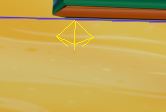Well, we have reached the the end of the 3D production pipeline once again friends. This time you followed the creation of a sword, from start to finish. The final step for us is the composition in Adobe Premiere Pro.
Its time to mix my animation with a few titles mixed in.
The final video lasts for half a minute and cycles through the stages of the build.
There really isn’t much to talk about technically with this one. A few titles were added in along with the audio, which was nice and royalty free and from incompetech.com if you want to check it out.
Now, talking of what could be done with my 3D model.
As it stands it might make a nice addition to a mobile game if optimised.
According to the forums at unity3d.com the best way to optimise a model for mobile is to make sure that:
- the poly count is fairly low
- not many materials are used
- and to use little to no shades.
























